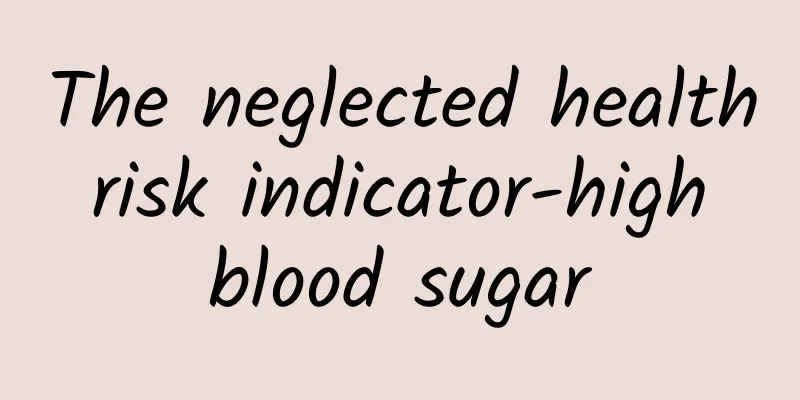The neglected health risk indicator-high blood sugar

|
"Hyperemia" can reflect the abnormal state of the body, damage cells, tissues, and organs, and is an independent risk factor or important risk factor for many chronic diseases. Like high blood pressure, high blood lipids, and high blood sugar, it is one of the important indicators for determining health risks. What is high blood sugar? Homocysteine (Hcy), also known as homocysteine in blood, is a sulfur-containing amino acid. Various factors can lead to the accumulation of total homocysteine (tHcy) levels in the blood, forming hyperhomocysteinemia (HHcy), also known as hyperhomocysteinemia. What are the risk factors for high blood sugar? Risk factors for high blood sugar: ①Genetic factors; ②Unhealthy lifestyles such as drinking and smoking; ③Age and gender: With age, blood sugar levels gradually increase. Male blood sugar levels are higher than female blood sugar levels, and female blood sugar levels are higher after menopause than before menopause. ④Diseases and drugs: Diseases such as renal dysfunction, hypothyroidism, severe anemia, and malignant tumors can be treated with methotrexate, nitric oxide, anticonvulsant drugs, diuretics, niacin, and other drugs to increase blood sugar levels. What diseases does high blood pressure increase? 1. High blood sugar levels in stroke are an independent risk factor for stroke. The risk of stroke in people with blood sugar levels higher than 10.50 μmol/L increases by 4.2 times. 2. Dementia Hcy promotes neurodegeneration, including Alzheimer's disease, Parkinson's disease, and vascular dementia. Hcy can be used to predict the risk of AD, which is not only related to cognitive impairment, but also to the degree of cognitive impairment. 3. Hypertension and cardiovascular disease The formation of atherosclerosis is attributed to the aggregation of homocysteine lipoproteins and microorganisms, which block blood vessels during the formation of vulnerable arterial plaques and lead to cardiovascular events. 4. Hypertension Hcy causes sodium reabsorption and changes the elasticity of the blood vessel wall, leading to hypertension. Hcy is positively correlated with systolic and diastolic blood pressure. Every increase of 5μmol/L can increase systolic blood pressure by 0.45mmHg and diastolic blood pressure by 0.47mmHg. With a baseline of 10μmol/L, 75% of Chinese hypertensive patients have high Hcy, of which 91% are male and 63% are female. Among people over 45 years old, 75% of men have Hcy exceeding 10.5μmol/L and 50% of women have Hcy exceeding 10.7μmol/L. 5. Diabetes complications: Diabetic patients with hypertension are more likely to suffer from large vessel damage and microvascular lesions. 6. Chronic Kidney Disease The kidney plays a key role in the metabolic clearance of homocysteine. High blood homocysteine is negatively correlated with renal function impairment and glomerular filtration rate, and is an independent risk factor for the progression of chronic kidney disease. 7. Bone hyperlipidemia has adverse effects on osteoblasts and osteoclasts, destroys the cross-linking of collagen molecules, reduces bone mass, and leads to decreased bone strength. 8. Pregnancy diseases Hemostasis can lead to gestational hypertension, gestational diabetes, placental vascular disease, habitual abortion, etc. through mechanisms such as vascular endothelial damage, poor chorionic vascularization, and abnormal embryonic development. Hemostasis is also an independent risk factor for neural tube defects, directly affecting the degree of neural tube closure, which in turn leads to fetal malformations. 9. Male diseases Hyperemia can cause infertility by affecting sperm production and sperm function. 10. Tumors are closely related to abnormal DNA synthesis and methylation. Studies have found that blood levels of methyltransferases are significantly increased in patients with various malignant tumors, such as breast cancer, liver cancer, gastric cancer, and lung cancer, and can be used as a tumor marker for malignant tumors. 11. Liver disease The liver is an important organ for Hcy metabolism. When liver cells are damaged, the blood level of Hcy will increase. In turn, high blood levels can enhance oxidative stress, cause liver lipid peroxidation, induce liver cell damage and apoptosis, and aggravate liver damage. Diagnostic criteria for hypertension Adult hypertension is divided into mild (10~15μmol/L), moderate (15~30μmol/L) and severe (>30μmol/L). Pregnant women and children are special populations, and their blood sugar levels should be lower than the adult reference value. How to treat high blood pressure? 1. Healthy lifestyle interventions such as quitting smoking, limiting alcohol consumption, eating a balanced diet, and increasing exercise can help lower blood cholesterol levels. Nutritional treatment ① Folic acid: 0.8 mg of folic acid per day is the best dose for lowering blood sugar. For patients with gene mutations, 5-methyltetrahydrofolate can be supplemented at the same time, which has a better effect on lowering blood sugar; ② Vitamin B12; ③ Vitamin B6, combined with folic acid and vitamin B12, has a significant synergistic effect. ④ Natural betaine; ⑤ Choline; ⑥ Combined supplementation: The "Complete Book of Chinese Nutrition Science" (2nd edition) recommends the use of a 3 + X complex nutrient program, namely natural betaine + folic acid + vitamin B6 + auxiliary nutrients. "Hypertension" recommends a daily blood sugar-lowering program of 1000 mg of natural betaine, 0.8 mg of folic acid, 2.8 mg of vitamin B2, 2.8 mg of vitamin B6, and 4.8 μg of vitamin B12. ⑦ Precise supplementation: According to the polymorphism of the gene, a personalized and precise supplementation program is formulated in combination with the levels of nutrients such as folic acid, vitamin B12, vitamin B6, choline, and betaine. For patients with non-genetic hypertensive syndrome, the focus should be on supplementing the nutrients that are severely deficient based on the test results of folic acid, vitamin B12, vitamin B6, and choline. |
<<: The latest research confirms: exercise really can fight cancer!
Recommend
Breast itching after pregnancy
There are more and more symptoms occurring during...
Ultrasound appearance of breast fibroadenoma
A woman's breast is a very soft place. It is ...
What are the symptoms of early pregnancy
What are the symptoms of early pregnancy? Experts...
What diseases can Fule Granules cure?
With the development of medical technology, more ...
Stomach discomfort after taking birth control pills
Is it normal to have stomach pain after taking bi...
The reason why female secretions are like tofu dregs
We all know that women's secretions are basic...
What causes armpit cramps?
People's living standards are constantly impr...
How to cure styes in pregnant women the fastest
Stye is a disease in traditional Chinese medicine...
Why is the urine not clean?
In daily life, the problem of incomplete urinatio...
A mother and her son died of carbon monoxide poisoning while brewing tea around a stove. Here are 5 facts about drinking tea!
This winter, cooking tea around the stove is very...
Feeling like something is stuck in throat during pregnancy
Everyone has experienced the uncomfortable feelin...
What to do if a pregnant woman is stung by a bee
We all know that the fetus is very sensitive. If ...
What causes lower abdominal pain during sex?
Marital life, or what we call sex life, is a medi...
How many days does the mother need to stay in confinement?
Nowadays, young women don’t know much about thing...
The dangers of high estradiol levels in women
Estradiol is a relatively important hormone in th...









